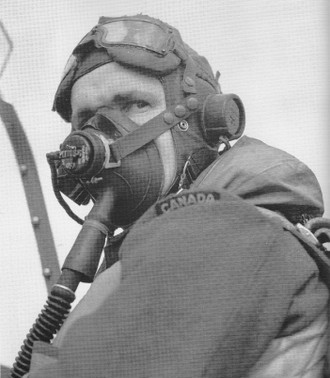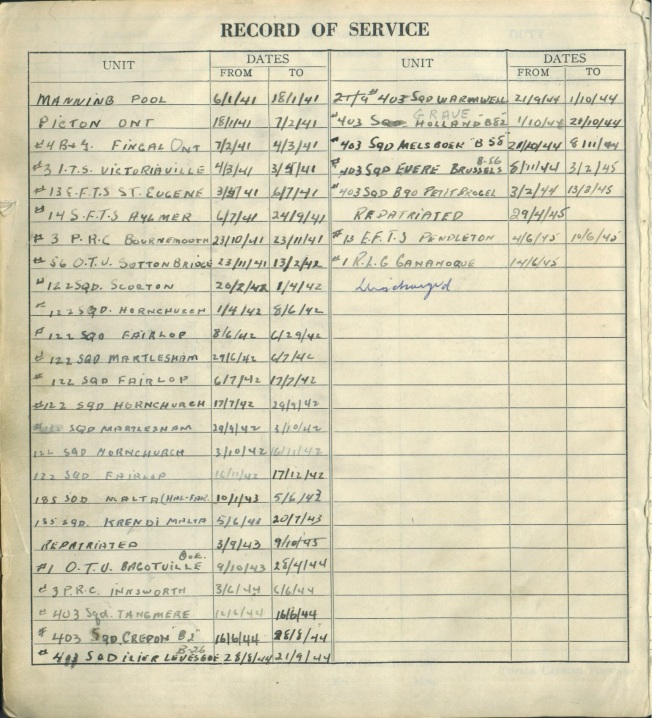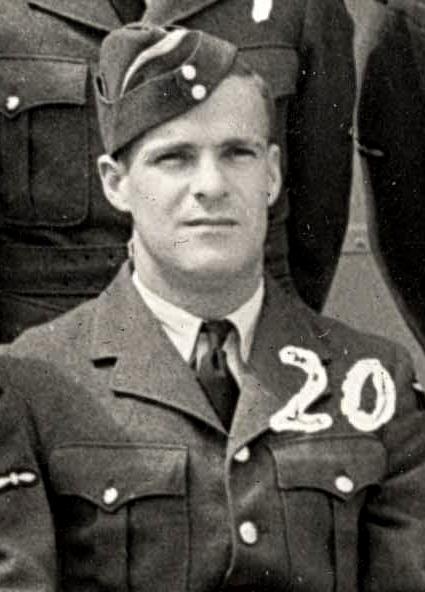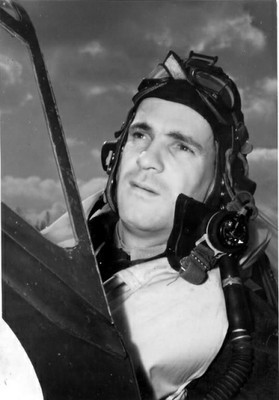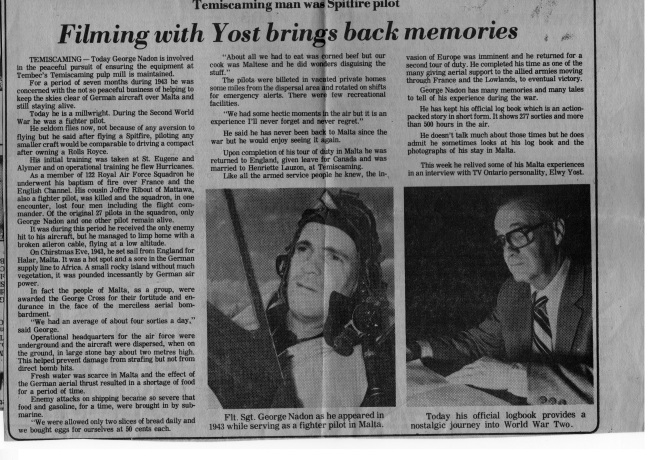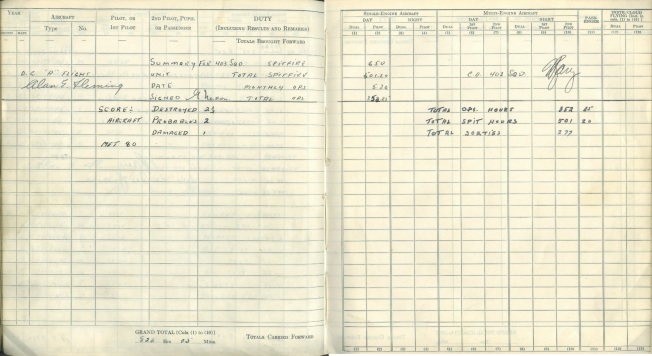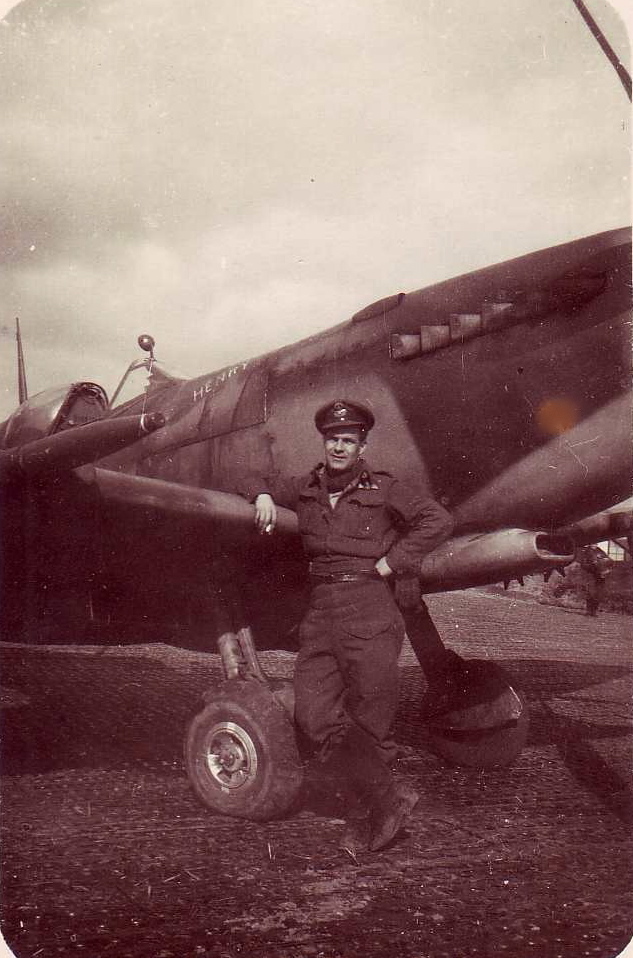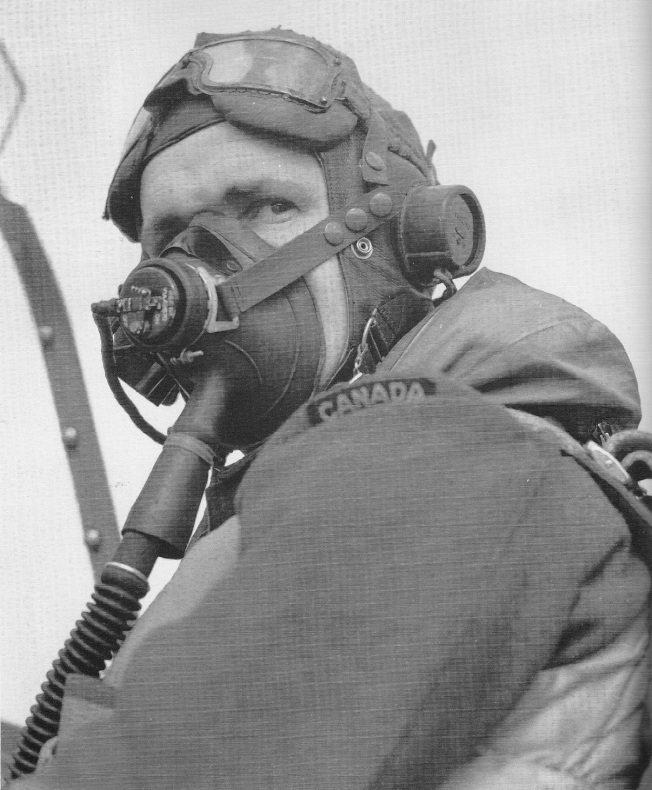Voici comment le monde se souvenait auparavant de ce pilote de Spitfire…
Les petites amies et la bière…
Dorénavant on se souviendra de lui tout autrement…
Un des enfants de Georges lui avait probablement déjà posé cette question:
Papa, qu’est-ce que tu faisais durant la guerre?
Georges Nadon avait probablement répondu…
Continue à faire tes devoirs. Je te raconterai tout ça plus tard.
Georges Nadon selon ses enfants a très peu parlé de la guerre. Les états de service de Georges Nadon raconteront tout, tout comme son logbook que je partagerai lors des prochains billets sur ce blogue dédié à la mémoire de Georges Nadon.
Premier arrêt, le Manning Pool où il demeurera 12 jours (du 6 au 18 janvier 1941).
Puis en route vers Picton en Ontario pour 20 jours (du 18 janvier au 7 février 1941). Visite virtuelle de Picton en cliquant ici. Puis c’est le No. 4 Bomber and Gunnery School (No. 4 B&GS) à Fingal en Ontario, pour une durée d’un mois seulement (du 7 février au 4 mars 1941).
(Wikipedia) RCAF Station Fingal was a Second World War British Commonwealth Air Training Plan (BCATP) station located near Fingal, Ontario, Canada. It was operated and administered by the Royal Canadian Air Force (RCAF).
Fingal hosted No. 4 Bomber and Gunnery School (No. 4 B&GS), which trained bomb aimers and air gunners. The school opened on 25 November 1940 and closed 17 February 1945. Aircraft used included the Fairey Battle, Northrop Nomad, Westland Lysander, Bristol Bolingbroke and Avro Anson.[1] Bombing ranges were located near Melbourne, Frome, Tempo, and Dutton. There was also a bombing range on Lake Erie. A marine unit was based in Port Stanley.[2][3] Classroom facilities with residences were commandeered from Universities, Colleges, The station magazine was the “Fingal Observer”.
Ce séjour d’un mois seulement est très révélateur puisque le No. 4 B&G était une école d’entraînement pour les mitrailleurs et les bombardiers (bomb aimers). Georges Nadon a dû démontrer des aptitudes de pilote puisqu’on l’envoie dans un I.T.S., un Initial Training School pour recevoir un entraînemennt destiné aux étudiants-pilotes. C’est pourquoi il sera affecté au No. 3 I.T.S. à Victoriaville (du 4 mars 1941 au 3 mai 1941).
(Wikipedia) Initial Training Schools
Pilot and Air Observer candidates began their 26 or 28 week training program with four weeks at an Initial Training School (ITS). They studied theoretical subjects and were subjected to a variety of tests. Theoretical studies included navigation, theory of flight, meteorology, duties of an officer, air force administration, algebra, and trigonometry. Tests included an interview with a psychiatrist, the 4 hour long M2 physical examination, a session in a decompression chamber, and a “test flight” in a Link Trainer as well as academics. At the end of the course the postings were announced. Occasionally candidates were re-routed to the Wireless Air Gunner stream at the end of ITS.
Il sera affecté ensuite à un Elementary Flying Training school, le No. 13 E.F.T.S. à St-Eugène en Ontario (du 3 mai 1941 au 6 juillet 1941).
(Wikipedia) Elementary Flying Training Schools
An Elementary Flying Training School (EFTS) gave a recruit 50 hours of basic flying instruction on a simple trainer like the De Havilland Tiger Moth, Fleet Finch, or Fairchild Cornell over 8 weeks.[2] Elementary schools were operated by civilian flying clubs under contract to the RCAF and most of the instructors were civilians. For example, No. 12 EFTS Goderich was run by the Kitchener-Waterloo Flying Club and the County of Huron Flying Club.[3] The next step for a pilot was the Service Flying Training School.
No. 1 Malton, Ontario (Moth)
No. 2 Fort William, Ontario (Moth)
No. 3 London, Ontario (Finch)
No. 4 Windsor Mills, Quebec (Finch and Moth)
No. 5 Lethbridge,Alberta, moved to High River, Alberta (Moth and Cornell)
No. 6 Prince Albert, Saskatchewan (Moth and Cornell)
No. 7 Windsor, Ontario (Finch)
No. 8 Vancouver, British Columbia, moved to Boundary Bay, British Columbia [3] (Moth)
No. 9 St. Catharines, Ontario (Moth)
No. 10 Hamilton, Ontario, moved to Pendleton, Ontario (Moth and Finch)
No. 11 Cap-de-la-Madeleine, Quebec (Finch and Cornell)
No. 12 Goderich, Ontario (Finch)
No. 13 St. Eugene, Ontario(Finch)
No. 14 Portage la Prairie, Manitoba (Moth and Finch)
No. 15 Regina, Saskatchewan (Moth and Cornell)
No. 16 Edmonton, Alberta (Moth and Finch)
No. 17 Stanley, Nova Scotia (Finch and Moth)
No. 18 Boundary Bay, British Columbia (Moth) [8]
No. 19 Virden, Manitoba (Moth and Cornell)
No. 20 Oshawa, Ontario (Moth)
No. 21 Chatham, New Brunswick (Finch)
No. 22 L’Ancienne-Lorette, Quebec (Finch)
No. 23 Davidson, Saskatchewan, moved to Yorkton, Saskatchewan
No. 24 Abbotsford, British Columbia (Cornell)
No. 25 Assiniboia, Saskatchewan — originally No. 34 RAF (Cornell)
No. 26 Neepawa, Manitoba — originally No. 35 RAF (Moth)
No. 31 DeWinton, Alberta — taken over by the Toronto Flying Club. (Moth, Stearman and Cornell)
No. 32 Bowden, Alberta (Moth, Stearman and Cornell)
No. 33 Caron, Saskatchewan (Cornell)
No. 34 Assiniboia, Saskatchewan — taken over by Winnipeg Flying Club as No. 25 EFTS [3] (Moth)[8]
No. 35 Neepawa, Manitoba — taken over by Moncton Flying Club as No. 26 EFTS [3] (Moth and Cornell)
No. 36 Pearce, Alberta (Moth and Stearman)
Le No. 13 E.F.T.S. fera l’objet de nos prochaines articles avant de se diriger au No. 14 S.F.T.S. à Alymer en Ontario, où fut prise cette photo.
Georges Nadon fut affecté à cette base du 6 juillet 1941 au 24 septembre 1941.
Georges Nadon recevra ses ailes de pilote au No. 14 Service Flying Training School à Alymer en september 1941, puis sera envoyé outre-mer après quelques semaines de permission pour dire au revoir à sa famille.
Nous avons quelques photos prise lors de l’entraînement de Georges à Alymer.
LAC Scott et LAC Joffre Ribout (No.14 S.F.T.S. Alymer)
Joffre Ribout (No.14 S.F.T.S. Alymer)
Georges Nadon (No. 13 E.F.T.S. St-Eugène ou No.14 S.F.T.S. Alymer)
Sergeant Trumley, son instructeur (No.14 S.F.T.S. Alymer)
liquez ici pour une video de cette école d’entraînement training school.

